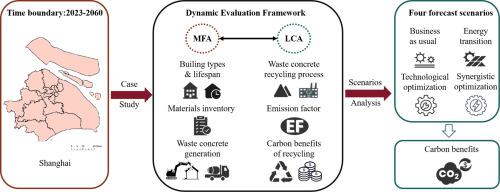From waste to carbon benefits - A dynamic spatiotemporal model for assessing carbon reduction potential in urban concrete recycling systems
IF 10.9
1区 环境科学与生态学
Q1 ENGINEERING, ENVIRONMENTAL
引用次数: 0
Abstract
Urbanization has intensified the challenge of managing waste concrete, thereby making recycling essential for sustainable resource management. However, the absence of a methodology to assess the carbon reduction potential of municipal waste concrete recycling limits the accurate quantification of emission reduction potential. This study integrates material flow analysis and life cycle assessment to develop a dynamic model that captures regional spatial variations alongside temporal changes in energy consumption and technological advancement. Taking Shanghai as a case study, we project that waste concrete generation will peak at 18 million tons in 2052, with cumulative unrecycled waste reaching 290 million tons by 2060. Over the period 2023–2060, central districts generate 37.82% of waste but rely on peripheral processing, a spatial mismatch requiring cross-regional facility planning and phased capacity expansion strategies. Through scenario analysis, technological optimization (TO) scenario, which achieves a 48% reduction in baseline emissions, yields greater cumulative carbon benefits than the energy transition (ET) scenario; the synergistic optimization (SO) scenario yields the lowest cumulative carbon benefits, 95.4 kt CO2e. The scenario results indicate that deeper decarbonization may shrink carbon mitigation potential of recycled waste. This model developed in this study provides a practical tool to evaluate waste recycling benefits under different future scenarios and to inform regional decisions such as coordinated facility siting and capacity expansion.

从废物到碳效益——一个评估城市混凝土回收系统碳减排潜力的动态时空模型
城市化加剧了管理废弃混凝土的挑战,从而使回收成为可持续资源管理的必要条件。然而,缺乏一种方法来评估城市废混凝土回收的碳减排潜力,限制了减排潜力的准确量化。本研究将物质流分析和生命周期评估相结合,建立了一个动态模型,以捕捉能源消耗和技术进步的区域空间变化以及时间变化。以上海为例,我们预计2052年废混凝土产生量将达到1800万吨的峰值,到2060年累计不可回收废物将达到2.9亿吨。在2023-2060年期间,中心地区产生了37.82%的垃圾,但依赖于周边处理,这种空间不匹配需要跨区域的设施规划和分阶段的产能扩张战略。通过情景分析,技术优化(TO)情景比能源转型(ET)情景产生了更大的累积碳效益,技术优化(TO)情景实现了基线排放量减少48%;协同优化(SO)方案产生的累积碳效益最低,为95.4 kt CO2e。情景结果表明,深度脱碳可能会缩小回收废物的碳减排潜力。本研究建立的模型提供了一个实用的工具来评估不同未来情景下的废物回收效益,并为区域决策提供信息,如协调设施选址和产能扩张。
本文章由计算机程序翻译,如有差异,请以英文原文为准。
求助全文
约1分钟内获得全文
求助全文
来源期刊

Resources Conservation and Recycling
环境科学-工程:环境
CiteScore
22.90
自引率
6.10%
发文量
625
审稿时长
23 days
期刊介绍:
The journal Resources, Conservation & Recycling welcomes contributions from research, which consider sustainable management and conservation of resources. The journal prioritizes understanding the transformation processes crucial for transitioning toward more sustainable production and consumption systems. It highlights technological, economic, institutional, and policy aspects related to specific resource management practices such as conservation, recycling, and resource substitution, as well as broader strategies like improving resource productivity and restructuring production and consumption patterns.
Contributions may address regional, national, or international scales and can range from individual resources or technologies to entire sectors or systems. Authors are encouraged to explore scientific and methodological issues alongside practical, environmental, and economic implications. However, manuscripts focusing solely on laboratory experiments without discussing their broader implications will not be considered for publication in the journal.
 求助内容:
求助内容: 应助结果提醒方式:
应助结果提醒方式:


